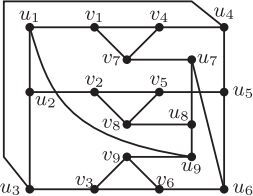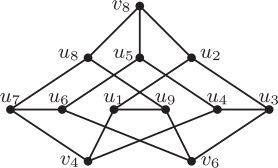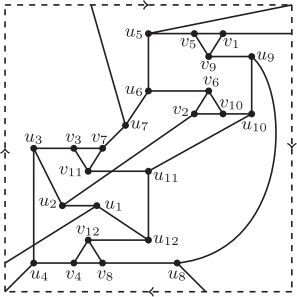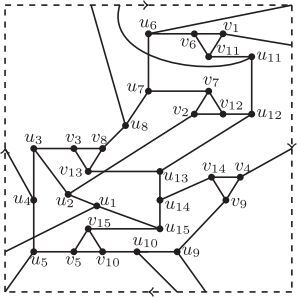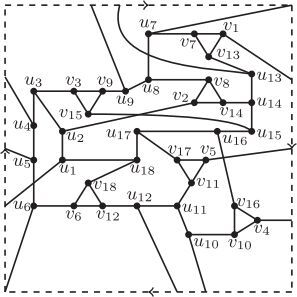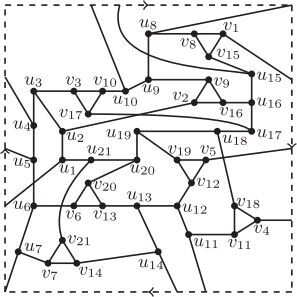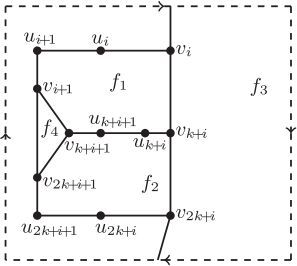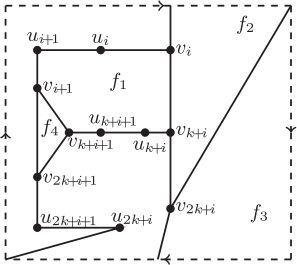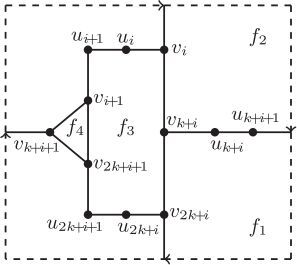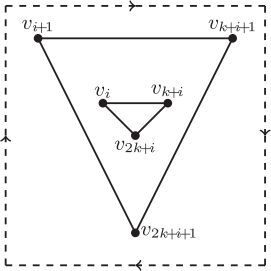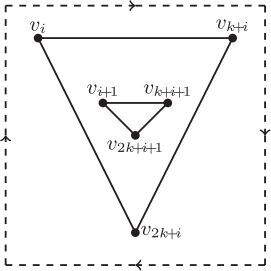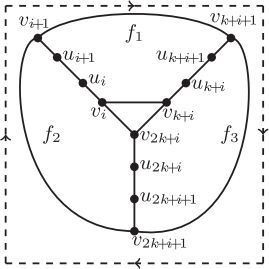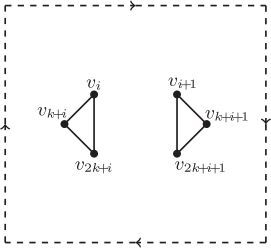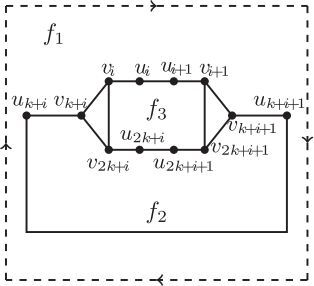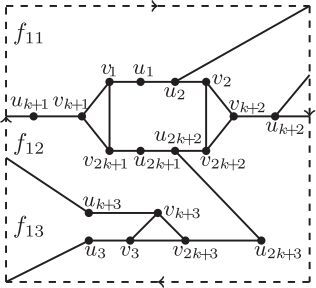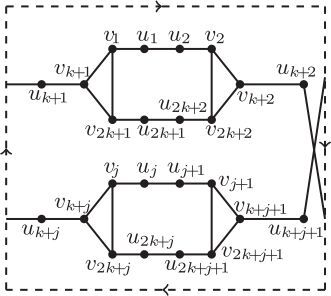 ?Mathematical formulae have been encoded as MathML and are displayed in this HTML version using MathJax in order to improve their display. Uncheck the box to turn MathJax off. This feature requires Javascript. Click on a formula to zoom.
?Mathematical formulae have been encoded as MathML and are displayed in this HTML version using MathJax in order to improve their display. Uncheck the box to turn MathJax off. This feature requires Javascript. Click on a formula to zoom.ABSTRACT
The crossing number of a graph G in a surface Σ, denoted by , is the minimum number of pairwise intersections of edges in a drawing of G in Σ. Let k be an integer satisfying
, the generalized Petersen graph
is the graph with vertex set
and edge set
the subscripts are read modulo
In this paper we investigate the crossing number of
in the projective plane. We determine the exact value of
is k–2 when
moreover, for
we get that
1 Introduction
A surface Σ means a compact, connected 2-manifold. It is known that there are two kinds of closed surfaces, orientable and nonorientable [Citation8]. Every closed connected orientable surface is homeomorphic to one of the standard surfaces Sk , while each closed connected nonorientable surface is homeomorphic to one of Nk
. In particular, the projective plane, N1, is a 2-manifold obtained by identifying every point of the 2-sphere with its antipodal point.
Let be a simple graph with vertex set V and edge set E. Let D be a drawing of the graph G in a surface
we denote the number of pairwise intersections of edges in D by
, or by v(D) when there is no ambiguity. The crossing number of G in a surface Σ, denoted by
, is the minimum number of pairwise intersections of edges in a drawing of G in Σ, i.e.,
In particular, the crossing number of G in the plane S0 is denoted by cr(G) for simplicity. It is well known that the crossing number of a graph in a surface Σ is attained only in good drawings of the graph, which are the drawings where no edge crosses itself, no adjacent edges cross each other, no two edges intersect more than once, and no three edges have a common point.
In a drawing D of in a surface
if an edge is not crossed by any other edge, we say that it is clean in D, otherwise, we say it is crossed. Moreover, let
, we say F is clean in D if all of the edges in F are clean, otherwise, we say F is crossed.
Let A and B be two (not necessary disjoint) subsets of the edge set E, the number of crossings involving an edge in A and another edge in B is denoted by In particular,
is denoted by
By counting the number of crossings in D, we have
Lemma 1.
Let A, B, C be mutually disjoint subsets of E, then
Computing the crossing number of a given graph is, in general, an elusive problem. Garey and Johnson have proved that the problem of determining the crossing number of an arbitrary graph in the plane is NP-complete [Citation7]. Because of its difficulty, there are limited results concerning on this problem, see [Citation1–4, Citation12–14, Citation16, Citation23] and the references therein. The Petersen graph plays the role of counterexample to many conjectures. And its generalization, the generalized Petersen graph P(n, k), is of great interest to the research community. Exoo, Harary and Kabell began to study the crossing number of P(n, k) in S0 and they worked out the case when k = 2 [Citation5]. For the case k = 3, Fiorini proved that [Citation6], later on, Richter and Salazar [Citation17] determined the crossing number of
to be t + h if
and t + 3 if h = 1, for each
, with the single exception of P(9, 3). We tried to obtain
when n can be expressed as a function of k, and proved that
for
[Citation22].
As for the crossing number of graphs in a surface other than the plane, it is not surprising that the results are even more limited: only the crossing number of Cartesian product graph in N1 [Citation19], the crossing number of the complete graph K9 in S2 [Citation20], the crossing number of the complete bipartite graph
in a surface with arbitrary genus [Citation18], the crossing number of
either in N1 or in S1 [Citation9, Citation10], the crossing number of the circulant graph
in N1 [Citation11], and the crossing number of the Hexagonal graph
in a surface with arbitrary genus [Citation21] have been determined. These facts motivate us to investigate the crossing number of
(
) in the projective plane, the main theorem of this paper is
Theorem 1.
When we have
. Moreover, for
we have
Let us give an overview of the rest of this paper. Some basic notations are introduced in Section 2. Section 3 is devoted to the proof of Theorem 1 by investigating the upper and lower bound of , respectively. The lower bound of
is based on the result of Lemma 4, which will be proved finally in Section 4.
2 Preliminaries
Let be a graph in a surface Σ. A cycle C on Σ is called contractible if
is disconnected and one of the components is homeomorphic to an open disc, otherwise it is named non-contractible.
For , we denote by
the graph obtained from G by deleting all edges in F. Furthermore, we also use F to denote the subgraph induced on the edge set F if there is no ambiguity.
Let k be an integer greater than or equal to 3. The generalized Petersen graph is the graph with vertex set
and edge set
the subscripts are read modulo
To seek the structure of , we find it is helpful to partite the edge set
into several subsets Ei and Hi as follows. For
let
and let
the subscripts are expressed modulo
Set It is not difficult to see that
(1)
(1) and that
is homeomorphic to
for each
.
Note that three edges and
form a 3-cycle in Ei, which is denoted by ECi throughout the following discussions. Formally,
Let D be a good drawing of in the projective plane. We define a function
(
) counting the number of crossings related to Hi in D as follows:
(2)
(2)
In the rest of the discussions, we find the following definition is useful.
Definition 1.
An -clean drawing of
is a good drawing of
in the projective plane such that
is clean.
By EquationEqs. (1)(1)
(1) and Equation(2)
(2)
(2) and by counting the number of crossings in D, we get
Lemma 2.
Let D be an -clean drawing of
, then
3 Proof of Theorem 1
In the beginning of this section, we obtain the upper bound of by a brief proof based on some former results.
Lemma 3.
, and
for
Proof.
Wilson’s Lemma states that the crossing number of a non-planar graph in the projective plane is strictly less than its crossing number in the plane [Citation19]. Combining this fact with the result that [Citation6] and that
for
[Citation22], the lemma follows easily. □
Our main efforts are made to establish the lower bound of which is based on the lemma below.
Lemma 4.
For let D be an
-clean drawing of
. Then
We postpone its proof to Section 4. By assuming Lemma 4, we can prove the lower bound of immediately.
Lemma 5.
for
Proof.
We prove the lemma by induction on k. First of all, it is seen from and that is a subdivision of
, which is one of minimal forbidden subgraphs for the projective planarity (see Appendix A in [Citation15]), therefore, the induction basis
holds. Suppose that
when
consider now the graph
Let D be a good drawing of
in
Case 1.
There exists an integer i such that Ei is crossed in D.
Without loss of generality, we may assume that By deleting the edges of E1 in D, we get a good drawing D0 of
in N1 with at least k–3 crossings by the induction hypothesis, thus
Case 2.
Ei is clean in D for every .
Then D is an -clean drawing of
. Due to Lemma 4,
holds.
Therefore, when
□
Based on the former lemmas, we can prove Theorem 1 in the following.
The proof of Theorem 1. demonstrate good drawings of in N1 with k–2 crossings when
thus
Together with Lemmas 3 and 5, it is confirmed that
for
For we have
due to Lemmas 3 and 5. The proof is completed. □
4 The proof of Lemma 4
For let
(3)
(3)
The following observation is obvious, but since it is appears several times in the rest of the paper, we state it formally.
Observation 1. Let D be an -clean drawing of
, then Ei is clean for all
Lemma 6.
For let D be an
-clean drawing of
such that one of the 3-cycles ECi and
is non-contractible. Then
Proof.
Without loss of generality, assume that ECi is non-contractible, for the other case, the proof is analogous. Then is contractible, since otherwise, two non-contractible cycles ECi and
will cross each other at least once in
a contradiction to Observation 1.
Suppose to the contrary that . Then the three edges of Hi cannot cross each other by EquationEq. (2)
(2)
(2) . By above analyses, there are three possibilities of the subdrawing of Ri, see . It is seen that, in each subdrawing of
the projective plane has been divided into four regions.
Firstly, we consider the case that the subdrawing of Ri is drawn as in . Consider now the subgraph . It is asserted that all of the vertices of
lie in the same region in the subdrawing of Ri by Observation 1. Furthermore, they cannot lie in the region labeled
otherwise the edge
will cross
at least once, a contradiction to Observation 1. The following three cases are investigated.
Case 1.
The vertices of lie in the region labeled
Then the edge and the path
will cross Hi at least once, respectively, which implies that
by EquationEq. (2)
(2)
(2) , a contradiction.
Case 2.
The vertices of lie in the region labeled
Then the edge and the path
will cross Hi at least once, respectively, which implies that
, a contradiction.
Case 3.
The vertices of lie in the region labeled
Then Hi will be crossed by the edge and by the path
at least once respectively, which yields that
, a contradiction.
Similar contradictions occur if the subdrawing of Ri is drawn as in . □
Lemma 7.
For let D be an
-clean drawing of
. If
is drawn as in , then
Proof.
Suppose to the contrary that By EquationEq. (2)
(2)
(2) , it is claimed that
Claim 1. The edges of Hi cannot cross each other in D.
If is drawn as in . Then Ri is shown as in by Observation 1 and Claim 1. Consider the subgraph
. It lies in one of the regions labeled
f2 and f3 by Observation 1 again. Assume that
lies in the region labeled
then the edge
and the path
will cross Hi at least once respectively. Hence, by EquationEq. (2)
(2)
(2) , we have
a contradiction. Similar contradictions occur if
lies in the region labeled f2 or
Using analogous arguments, we can also show that if
is drawn as in .
Lemma 8.
For let D be an
-clean drawing of
. If
is drawn as in and
then Ri is shown as in .
Proof.
First of all, we conclude that the edges of Hi cannot have internal crossings in D by the assumption that . Thus, there are two possibilities of the subdrawing of Ri in D. See and .
If Ri is drawn as in . Observation 1 enforces that lies in one of the regions labeled
f2 and f3. We may assume firstly that
lies in the region labeled
for the other cases the proof is similar. Under this circumstance, the edge
and the path
will cross Hi at least once respectively, therefore,
by EquationEq. (2)
(2)
(2) , a contradiction.
Thus, Ri is shown as in . □
Combining Lemma 7 with Lemma 8, we have
Lemma 9.
For let D be an
-clean drawing of
such that both ECi and
are contractible cycles. If Ri is not drawn as in , then
Proof.
Since both ECi and are contractible cycles, there are three possibilities of the subdrawing of
. See . Lemma 7 implies that
if
is drawn as in . Furthermore, Lemma 8 implies that
if Ri is not drawn as in . □
Now, we are ready to prove Lemma 4.
The proof of Lemma 4. Suppose to the contrary that
(4)
(4)
By Lemma 2, there exists an integer i such that since otherwise,
a contradiction to EquationEq. (4)
(4)
(4) . The following two cases are discussed: Case 1. there exists an integer i such that
and Case 2.
for every
and there exists an integer i such that
Case 1.
There exists an integer i such that
Without loss of generality, let Thus, we can get that
Claim 2. R1 is clean in D.
Furthermore, there exists another integer j satisfying
otherwise,
a contradiction to EquationEq. (4)
(4)
(4) .
Subcase 1.1.
j = 2 or j = k.
By symmetry, we only need to consider the case that j = 2. It follows from Lemma 6 that both EC1 and EC2 are contractible cycles since Moreover, Lemma 9 enforces that the subdrawing of R1 is shown as in by replacing all the indices i by 1.
Now, we consider the subgraph E3. All vertices of E3 lie in the region labeled f1, on whose boundary lie the vertices and
otherwise, we have
, contradicting Claim 2. Moreover, the edges of H2 cannot have internal crossings by EquationEq. (2)
(2)
(2) . All these arguments confirm that the only possibility of the subdrawing of
is shown as in . Note that the region labeled by f1 in has been separated into three regions, which are labeled by f11, f12 and f13.
Next, we consider the subgraph Ek (note that is crucial here for Ek being not equal to E3). By Observation 1, Ek lies in one of f11, f12 and f13. We may assume that Ek lies in f11, for other cases the proof is the same. Under this circumstance, H2 will be crossed by the edge
and by the path
at least once respectively. Therefore,
by EquationEq. (2)
(2)
(2) , a contradiction.
Subcase 1.2.
Since and
all of the cycles
ECj and
are contractible by Lemma 6. By Lemma 9, R1 (respectively Rj) is drawn as in by replacing all the indices i by 1 (respectively j).
Note that both and
are non-contractible curves. Therefore, they must cross each other in N1, which yields that
since
is clean in D, a contradiction to
.
Case 2.
for every
and there exists an integer i such that
Without loss of generality, let There exists an integer j (
) such that
since otherwise
and thus
since v(D) is an integer, a contradiction to EquationEq. (4)
(4)
(4) .
By Lemma 6, each cycle of
ECj and
is contractible. By Lemma 9, R1 (respectively Rj) is drawn as in by replacing all the indices i by 1 (respectively j). Note that both
and
are non-contractible curves. Then
since
. Furthermore, the crossed edge of H1 (respectively Hj) is
(respectively
). See . It is seen that two vertices u2 and uj do not lie on the boundary of the same region, thus the path
will cross H1 or Hj by Observation 1, a contradiction to the assumption that
.
All of the above contradictions enforce that if D is an
-clean drawing of
. □
5 Conclusions
This paper studies the crossing number of the generalized Petersen graph in the projective plane. When
, the exact value of
remains open. Does
or
? From the former proofs, we know that the problem of deciding the exact value of
can be reduced to the problem of whether there exists a good drawing of
in the projective plane with k–2 crossings. If the answer to the latter problem is” yes”, then we conclude that
, otherwise, we have
.
Acknowledgments
The authors would like to express their sincere thanks to the anonymous referees for their helpful comments to improve the paper.
Disclosure statement
No author associated with this paper has disclosed any potential or pertinent conflicts which may be perceived to have impending conflict with this work.
Data availability statement
No data were used to support this study.
Additional information
Funding
References
- Alfaro, C. A., Arroyo, A., Derňár, M, Mohar, B. (2018). The crossing number of the cone of a graph. SIAM J. Discrete Math. 32(3): 2080–2093.
- Bokal, D. (2007). On the crossing numbers of Cartesian products with paths. J. Combin. Theory Ser. B 97(3): 381–384.
- Bokal, D., Dvořák, Z., Hlinĕný, P., Leaños, J., Mohar, B, Wiedera, T. (2022). Bounded degree conjecture holds precisely for c-crossing-critical graphs with. Combinatorica 42(5): 701–728. c≤12.
- Ding, Z., Ouyang, Z., Huang, Y, Dong, F. (2022). New upper bounds for crossing numbers of crossing-critical graphs. Discrete Math 345(12): 113090.
- Exoo, G., Harary, F, Kabell, J. (1981). The crossing number of some generalized Petersen graphs. Math. Scand. 48: 184–188.
- Fiorini, S. (1986). On the crossing number of generalized Petersen graphs. Ann. Discrete Math 30: 225–242.
- Garey, M. R, Johnson, D. S. (1983). Crossing number is NP-complete. Siam J. On Algebraic and Discrete Methods 4(3): 312–316.
- Gross, J. L, Tucker, T. W. (1987). Topological Graph Theory. Toronto, Canada: Wiley.
- Ho, P. T. (2005). The crossing number of K4,n on the real projective plane. Discrete Math 304(1-3): 23–33.
- Ho, P. T. (2009). The toroidal crossing number of K4,n. Discrete Math 309(10): 3238–3248.
- Ho, P. T. (2012). The projective plane crossing number of the circulant graph C(3k;{1,k}). Discuss. Math. Graph Theory 32(1): 91–108.
- Kleitman, D. J. (1970). The crossing number of K5,n. J. Combin. Theory 9(4): 315–323.
- Klešč, M. (2001). The crossing numbers of Cartesian products of paths with 5-vertex graphs. Discrete Math 233(1-3): 353–359.
- Klešč, M., Staš, M, Petrillová, J. (2022). The crossing numbers of join of special disconnected graph on five vertices with discrete graphs. Graphs Comb 38(2): 35.
- Mohar, B, Thomassen, C. (2001). Graphs on Surfaces. Baltimore: Johns Hopkins University Press.
- Ouyang, Z., Huang, Y., Dong, F, Tay, E. G. (2021). Zip product of graphs and crossing numbers. J. Graph Theory 96(2): 289–309.
- Richter, R. B, Salazar, G. (2002). The crossing number of P(N,3). Graphs Comb 18(2): 381–394.
- Richter, R. B, Širáň, J. (1996). The crossing number of K3,n in a surface. J. Graph Theory 21(1): 51–54.
- Riskin, A. (1993). The projective plane crossing number of C3□Cn. J. Graph Theory 17(6): 683–693.
- Riskin, A. (1995). The genus 2 crossing number of K9. Discrete Math 145(1-3): 211–227.
- Wang, J., Cai, J., Lv, S, Huang, Y. (2019). The crossing number of Hexagonal graph H3,n in the projective plane. Discuss. Math. Graph Theory 42(1): 197–218.
- Wang, J., Yuan, Z, Huang, Y. (2011). On the crossing number of the generalized Petersen graph P(3k,k). ARS Comb 100: 395–407.
- Yang, Y., Wang, G., Wang, H, Zhou, Y. (2022). Disproof of a conjecture by Erdos and Guy on the crossing number of hypercubes. J. Graph Theory 100(3): 389–434.

